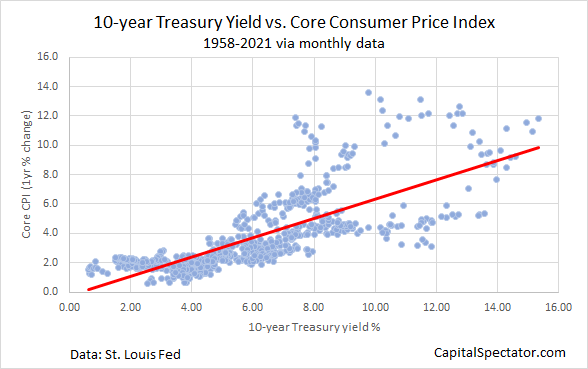Whatever your view of the higher inflation expectations of late, particularly if firmer pricing pressure persists, it would be a distinct change from what’s prevailed over the past 40 years. Disinflation/deflation (DD) has been a dominant macro factor since Paul Volcker broke the back of inflation in a run of uber-hawkish monetary policy in the early 1980s. Since then, DD reigns supreme, arguably to the point that the policy of promoting this outcome has become a problem in its own right.
Forty years ago, suppressing inflation and targeting lower interest rates were deemed a public good. But those objectives long ago lost their luster and are now seen as a sign of an economic challenge confronting the central bank.
But aren’t low interest rates and low/falling inflation always and everywhere a productive economic objective? You could convincingly make that case in the 1980s, but the macro landscape has evolved so that lower rates and pricing pressure appear to be reducing the odds of achieving stronger, sustainable economic growth.
Part of the problem is that low interest rates, in contrast with the general perception, are a sign of tight money. Economist Scott Sumner, among others, has been making this point for years: “Tight money leads to lower NGDP growth and lower interest rates over the sort of time period that matters for the issues that people care about.”
Empirically, it’s easy to demonstrate the relationship. For example, comparing the 10-year Treasury yield with the one-year change in the core Consumer Price Index since the late-1950s reveals a strong positive link: low (high) rates equate with low (high) inflation.

After decades of pursuing lower inflation (and lower interest rates), the critical question has become: Is this game plan broken? If so, what comes next?
Consider the Fed’s target rate. During every recession and recovery since the 1980s a recurring pattern has held: the Fed lowers interest rates, which are subsequently raised once the recovery takes hold. But the rebound in rates always tops out well below the previous high.

That brings us to the present situation. The Fed’s target rate is currently pinned to near-zero and the central bank has signalled that it has no plans to lift rates any time soon. Rising inflation expectations may call the Fed’s bluff and force it to hike rates sooner than expected. But it’s unclear if the current rebound inflation expectations is the start of a regime shift that breaks the back of the secular DD trend. Alternatively, the bounce in pricing pressure may be temporary and fade after so-called base effects related to last year’s pandemic effects wash out of the data.
We’ve been here before. Forecasts that inflation was about to rebound on a sustainable basis have come and gone. Nonetheless, the secular DD trend endures, and there are some compelling reasons for thinking that nothing’s changed.
For example, inflationistas warn that the surge in the Federal Reserve’s balance sheet is a sign that “money printing” will soon raise inflation for an extended period. The reality is that the sharp rise in money supply has largely driven up bank reserves without a meaningful impact on the real economy. Lending, for instance, remains relatively tame. That’s because the surge in bank reserves has remained trapped in the financial system and has yet to spill over into the wider economy, as Jeff Snider of Alhambra Investments has repeatedly explained and documented in recent years (see here, for instance).
Arguing that the decades-long DD trend has run its course remains premature. If DD persists, the Fed won’t be able to raise interest rates for the foreseeable future. When it does start hiking, and if history holds, the rate hikes for Fed funds will top out at a level below the previous high – roughly 2.5%.
The Fed has other monetary policy tools at its disposal, but these tools have been largely ineffective. That leaves the central bank with a policy dilemma: What does monetary policy look like over the next phase of the business cycle? If history is a guide, rates will only rise modestly, perhaps peaking well below 2.5% before the next recession begins. In turn, with rates already low, the standard plan of cutting rates will have less capacity for stimulating the real economy – a trend that’s been playing out for decades and one that’s set to potentially go into overdrive in the next phase of the business cycle.
What are the implications for the economy and monetary policy’s efficacy? They’re huge. Exactly how so is the mystery. All bets are off, however, if inflation ramps up significantly and persistently. But expecting that scenario requires dismissing a powerful secular trend that, so far, has proven the inflationistas wrong, again and again.
All of which brings us back to the perennial question: Is it different this time? If the answer is “no,” a very strange world of monetary policy awaits.
